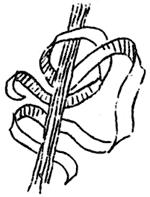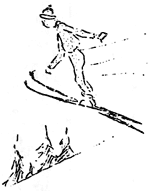Ice Ribbons at Crater Lake
By D. S. Libbey
Have you ever seen the frosted white ice ribbons with which Jack Frost adorns the stems of plants and weeds on frosty mornings? Ice ribbons are prone to occur in the chill of early winter when the ground is neither frozen nor covered with snow. The Cunila –Cunila origanoides – found up and down the Appalachian highland system is the favorite plant on which the ribbons form. Frequently similar ice ribbons have been observed growing from the stems of dead plants and weeds on the frosty slopes of the “hill” of our central plateaus.
The past winter very warm and moist weather occurred the last two weeks of November and the first few days of December. As a result the pumice slopes and bogs along the margins of Crater Lake National Park became thoroughly saturated with water from the nearly incessant mantle of fog and mist. Then came slightly colder weather with frost and ice. The chill of early mornings is the time to look for the ribbons which are tied by jolly old Jack Frost.
Ice ribbons were found in the bogs and in the canyon floors of the park to delight the lover of Nature. The ribbons observed were about two to three inches long and one inch wide, some transparent but most of them were frozen white, colored as the hoar frost of the dead of winter. It appears that the ribbons grow from the sides of dead stems and the water is supplied by the large sap tubes in the thin woody shell of the stems and not by the central pith. Since the ribbons are frequently found in dead stems broken off with one end sticking in a pool of water or a saturated bog, it is evident that a root system is not essential for the formation of these curious ice festoons.
Many partially formed ribbons were found, and from the various stages in the development observed, it is evident that the ribbons begin as a row, vertical with the stem, of closely space hair-like spicules of ice — show a fibrous structure running length-wise with a silky sheen and the ribbon in each case growing from the contact with the saturated stem. The stem is fed with the necessary water by capillary action; the moisture being conducted up through the sap ducts of the woody stems. The graceful curves develop as the knife blade thin ribbon is forced out by the freezing moisture as it is continuously fed from the saturated pores.
Crater Lake Annual Snow Carnival and Ski Tournament
By Ernest A. Rostel
The period from February 19 to 26 in Klamath County was devoted to the various activities of the Seventh Annual Snow Carnival and Ski Tournament. The contests were held at the ski jumping grounds which are located just below the south boundary of Crater Lake National Park and about six miles north of Fort Klamath. Various service clubs, the Pelicans – a local community group of Klamath Falls, and other organizations and individuals assisted the Crater Lake Ski Club with the program.
A feature of this year’s carnival was the presence and active competition of Scotty Allan of Nome and his dog team of Alaskan huskies. Scotty and his team added a touch of color to the festivities which smacked of the rigors and romances of the northland where he has won coveted riches and many honors. In the dog team race, the first ever to be included in the club’s activities, Scotty Allan won first honors, followed in second place by Virgil Jones, Pocatello, Idaho, musher. The team of 15 dogs pulled the “Princess of the Snows”, Miss Doris Noah, elected by Klamath County, on the sledge in a race against the several competitors in the feature event – the long thirty-two mile gruelling race to Crater Lake Lodge on the rim of Crater Lake and return. The dog team came in thirty minutes after Pete Hedburg, a blond Scandinavian from Modoc Point, winner of the race and the recipient of the large Sterling Silver loving cup named “The Shadow of the Klamath”. He negotiated the distance in four hours and thirty minutes. To obtain permanent possession of the cup Hedburg must be the victor a subsequent year.
Other features of the Carnival included ski jumping, various ski races, novelty contest and dances. The event which held second interest to the long thirty-two mile feature contest was the Trail Breakers race of sixteen miles which starts from the rim of Crater Lake. Out of the field of twelve entrants Delbert Denton of Fort Klamath took first place, covering the distance in one hour and forty-two minutes.
To indicate who “ski minded” the youths of Klamath County are there is one race named “The Future Defenders of the Klamath”. Contestants for this must be less than ten years of age.
Interest for years in the Crater Lake Ski Club has centered in the community of Fort Klamath, a village located near the site of the historic old fort and of that name, where Federal soldiers were stationed during the days of pioneer development in southern Oregon. It was from Fort Klamath that troops were dispatched during the time of the spectacular Modoc War.
This year the Annual Snow Carnival and Ski Tournament attracted so much interest that contestants and visitors were brought from many sections of the Pacific Northwest. In all over four thousand people attended the various features of the Carnival. The festival was probably the most successful ever held since the inauguration of the Annual Ski Tournament in 1927. The officials and personnel of Crater Lake National Park congratulate the Ski Club and assure them it was a pleasure to extend all possible cooperation.




